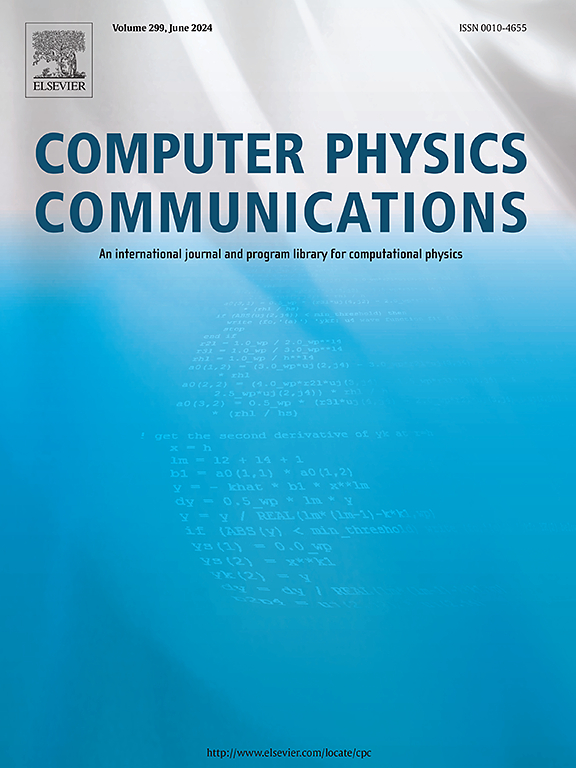Moshinsky brackets for a wide range of quantum numbers using generating functions
IF 7.2
2区 物理与天体物理
Q1 COMPUTER SCIENCE, INTERDISCIPLINARY APPLICATIONS
引用次数: 0
Abstract
We used a new Python code to reproduce the brackets for the Moshinsky harmonic oscillator, which was based on the generating function. We made these brackets by transforming the wave functions of two groups of coupled particle harmonic oscillators, and . To convert between the supplied position and momentum coordinates in both frames, we performed orthogonal transformations on nuclei with both low and high angular momentum.
In our derivation, we have used the expansion of the generating functions and in spherical coordinates in terms of harmonic oscillator wave functions. When we modified the Moshinsky brackets for two-coupled oscillator states, we used generating functions with two variables. The number of indices has significantly decreased compared to the oscillator brackets in previous references; this reduction in the program code's iterative process has yielded influential results. Compared to the previous version of the Moshinsky brackets code, the new Python code is easier to use. Our approach utilizes this code to assess Moshinsky brackets across a broad spectrum of quantum numbers. According to the revelation, adding more variables to the generating function makes the number of Moshinsky brackets that work for the higher body interactions increase.
Program summary
Program Title: GFBRACKETS
CPC Library link to program files: https://doi.org/10.17632/jvbnwp35rm.1
Licensing provisions: MIT
Programming language: Python
Supplementary material: Appendix
Nature of problem: The generating functions were used to obtain a concise representation of the oscillator states for single particles. This was done to formulate and compute the generalized version of the Moshinsky brackets and matrix elements of two-body operators. By enlarging sets of basis oscillator states, it becomes possible to cover interactions involving more than two bodies. This can be easily achieved using the expanded generating function to compute the Moshinsky brackets for high-quantum numbers.
Solution method: The Python code requires fewer iterations than similar codes generated by the method of the generating functions.
Additional comments including restrictions and unusual features: When calculating Moshinsky brackets for large quantum numbers, restrictions arise. There is no data for quantum numbers greater than 10 in the formation of reaction potential. Additionally, a transformation matrix can be used to switch from single-particle to centre-of-mass coordinates on a two-particle harmonic oscillator basis. This transformation is applicable even when the masses of the two particles are unequal.
使用生成函数求大范围量子数的莫辛斯基括号
我们使用新的 Python 代码重现了基于生成函数的莫辛斯基谐振子的括号。我们通过变换两组耦合粒子谐振子的波函数,即Φn1l1,n2l2,Λm1,m2,λ(r→1,r→2)和Φnala,nblb,Λma,mb,λ(r→a,r→b),制作了这些括号。在推导过程中,我们使用了球面坐标中的生成函数 e2p→.r→-p2 和 e2cpi.pj 在谐振子波函数方面的展开。当我们为双耦合振荡器状态修改莫辛斯基括号时,我们使用了具有两个变量的生成函数。与之前参考文献中的振荡器括号相比,指数数量明显减少;程序代码迭代过程的减少产生了有影响力的结果。与之前版本的莫辛斯基括号代码相比,新的 Python 代码更易于使用。我们的方法就是利用这段代码来评估量子数范围广泛的莫辛斯基括号。根据启示,在生成函数中添加更多变量会使对高体相互作用起作用的莫辛斯基括号的数量增加:GFBRACKETSCPC 程序文件库链接:https://doi.org/10.17632/jvbnwp35rm.1Licensing provisions:MIT编程语言:PythonSupplementary material:问题性质:生成函数用于获得单个粒子振荡器状态的简明表示。这样做是为了制定和计算广义版的莫辛斯基括号和双体算子的矩阵元素。通过扩大基振荡态集,就有可能涵盖涉及两个以上物体的相互作用。使用扩展生成函数计算高量子数的莫辛斯基括号,可以轻松实现这一目标:Python 代码所需的迭代次数少于通过生成函数方法生成的类似代码:在计算大量子数的莫辛斯基括号时,会出现一些限制。在形成反应势时,没有量子数大于 10 的数据。此外,可以使用转换矩阵在双粒子谐振子基础上从单粒子坐标转换到质量中心坐标。即使两个粒子的质量不相等,这种转换也适用。
本文章由计算机程序翻译,如有差异,请以英文原文为准。
求助全文
约1分钟内获得全文
求助全文
来源期刊

Computer Physics Communications
物理-计算机:跨学科应用
CiteScore
12.10
自引率
3.20%
发文量
287
审稿时长
5.3 months
期刊介绍:
The focus of CPC is on contemporary computational methods and techniques and their implementation, the effectiveness of which will normally be evidenced by the author(s) within the context of a substantive problem in physics. Within this setting CPC publishes two types of paper.
Computer Programs in Physics (CPiP)
These papers describe significant computer programs to be archived in the CPC Program Library which is held in the Mendeley Data repository. The submitted software must be covered by an approved open source licence. Papers and associated computer programs that address a problem of contemporary interest in physics that cannot be solved by current software are particularly encouraged.
Computational Physics Papers (CP)
These are research papers in, but are not limited to, the following themes across computational physics and related disciplines.
mathematical and numerical methods and algorithms;
computational models including those associated with the design, control and analysis of experiments; and
algebraic computation.
Each will normally include software implementation and performance details. The software implementation should, ideally, be available via GitHub, Zenodo or an institutional repository.In addition, research papers on the impact of advanced computer architecture and special purpose computers on computing in the physical sciences and software topics related to, and of importance in, the physical sciences may be considered.
 求助内容:
求助内容: 应助结果提醒方式:
应助结果提醒方式:


